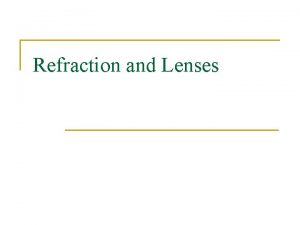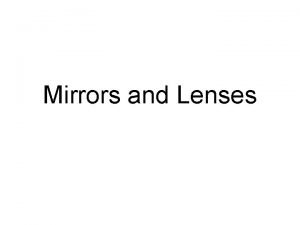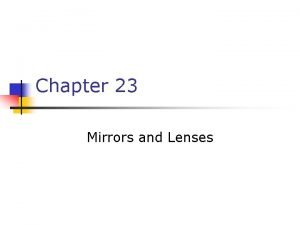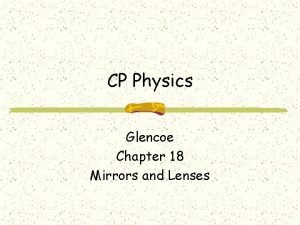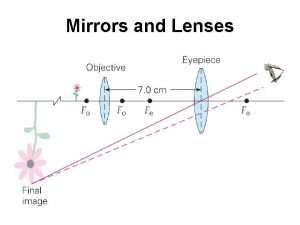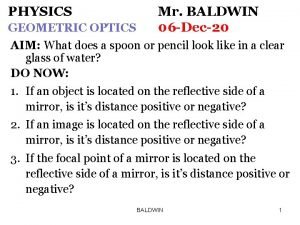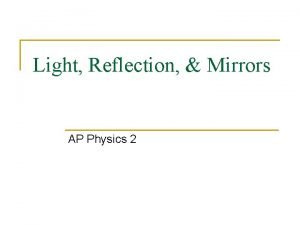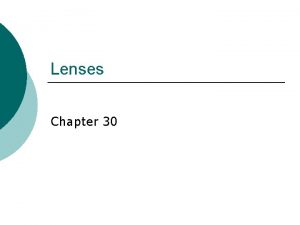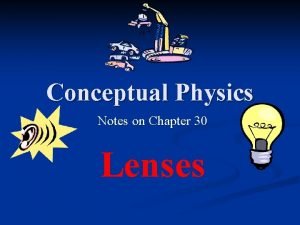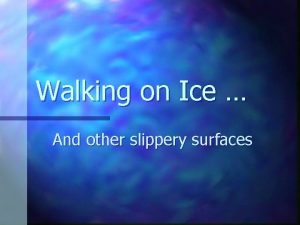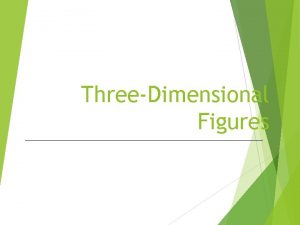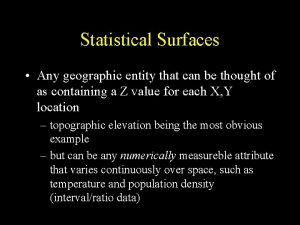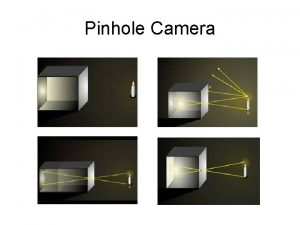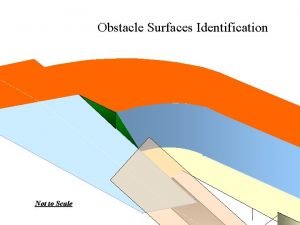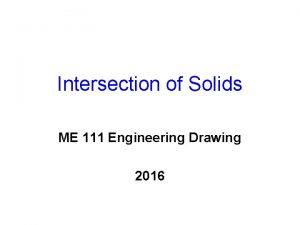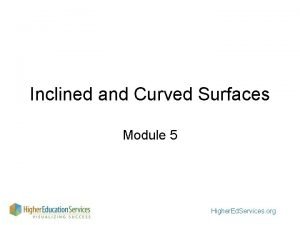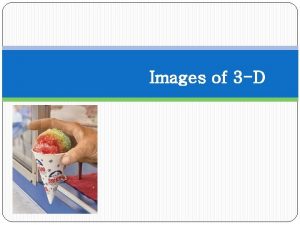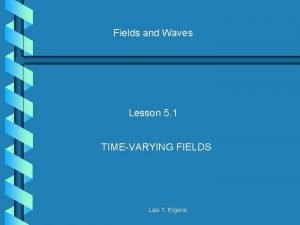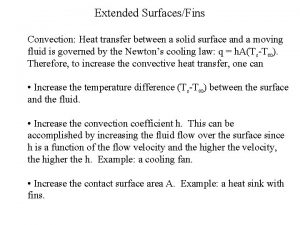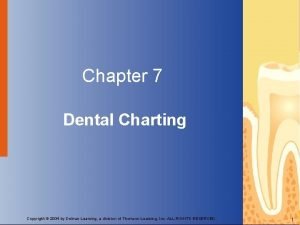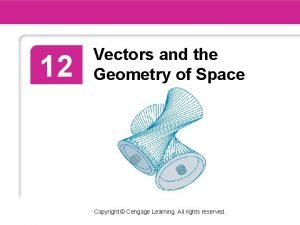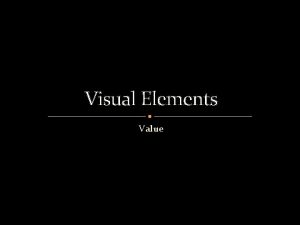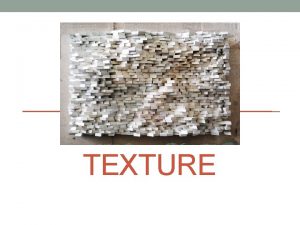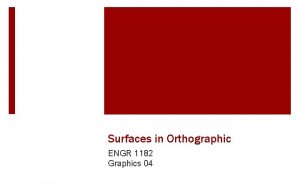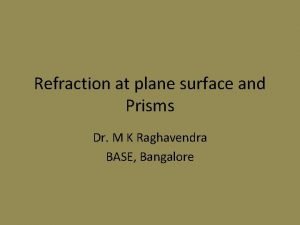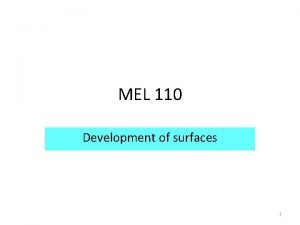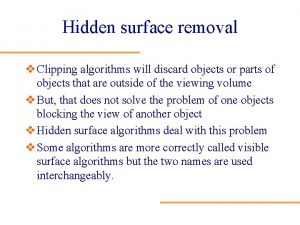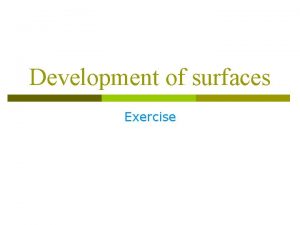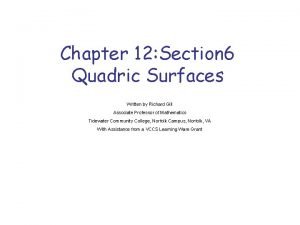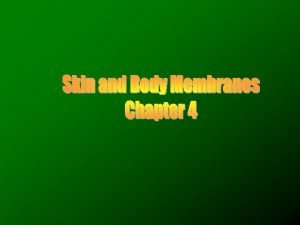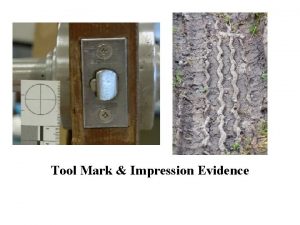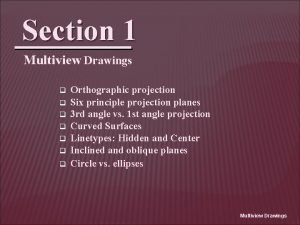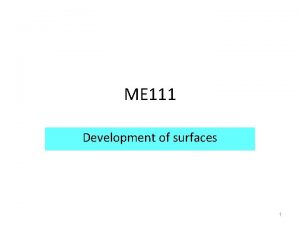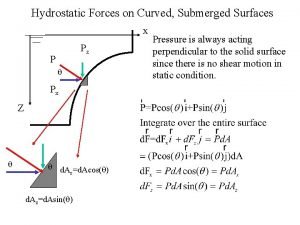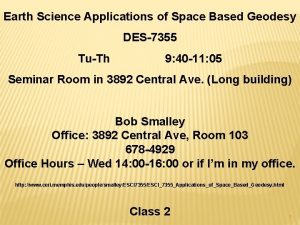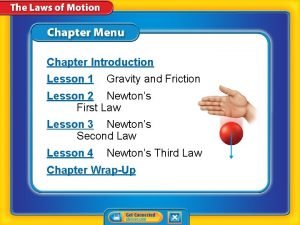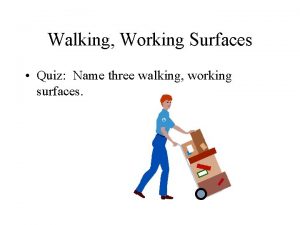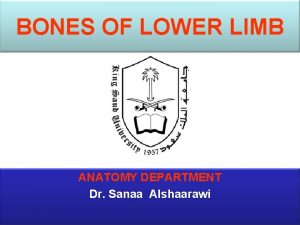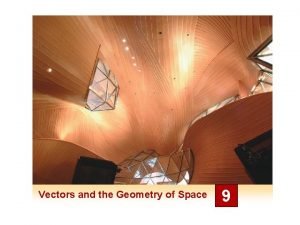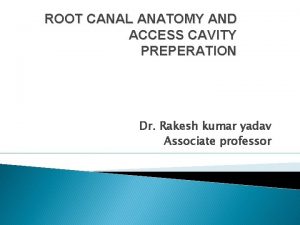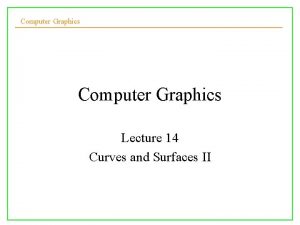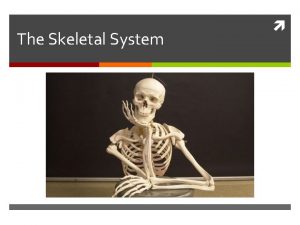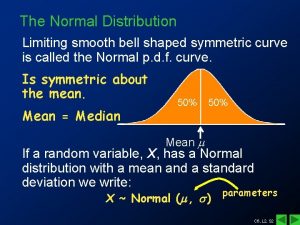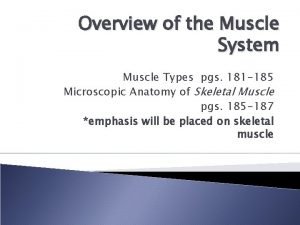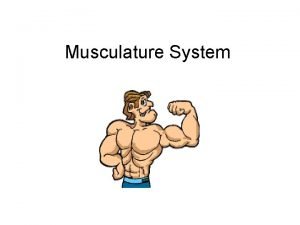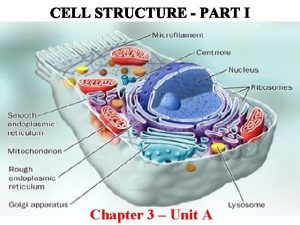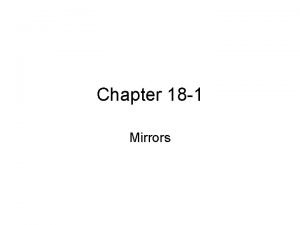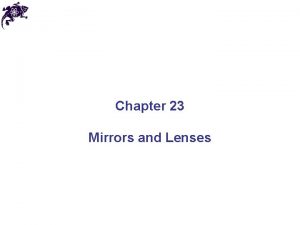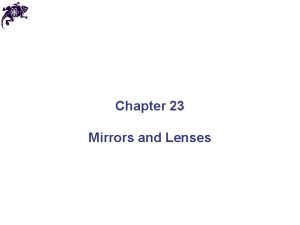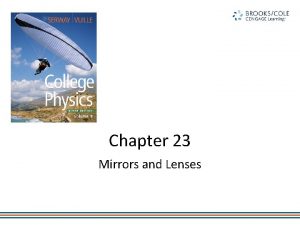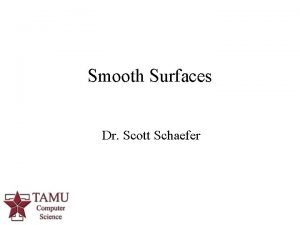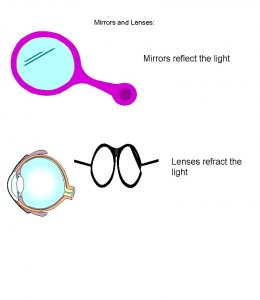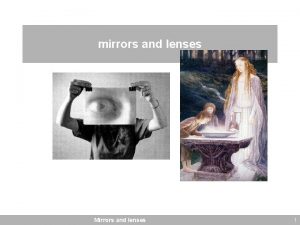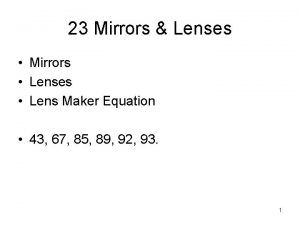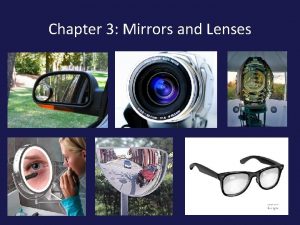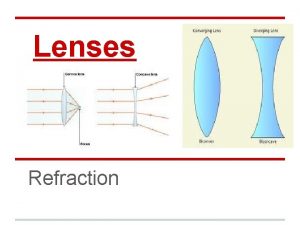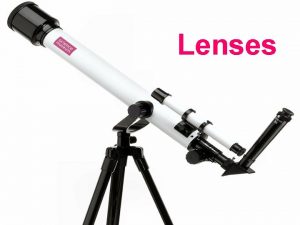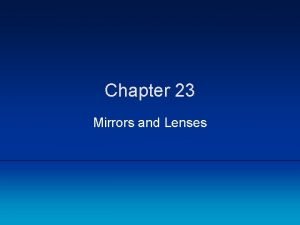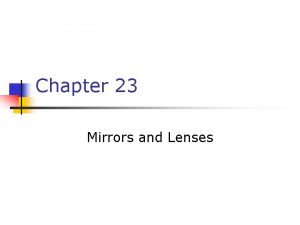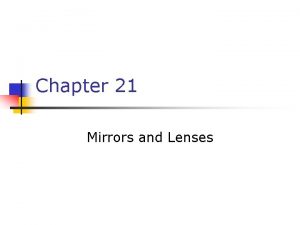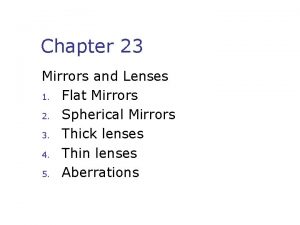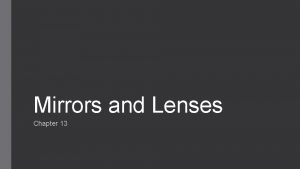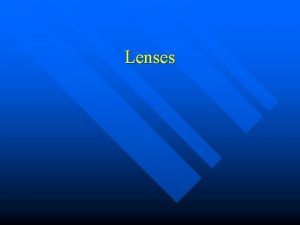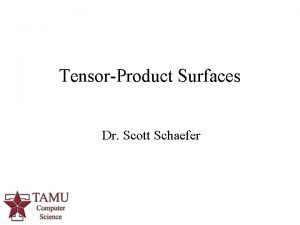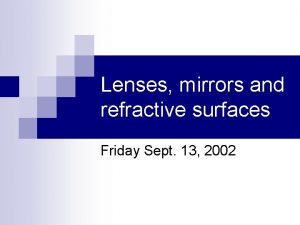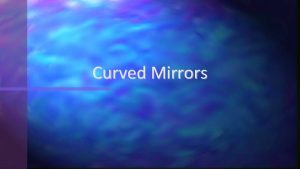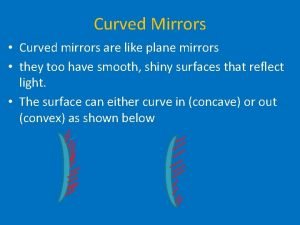Chapter 18 Mirrors Lenses Mirrors Smooth surfaces that






























































































- Slides: 94

Chapter 18 Mirrors & Lenses

Mirrors • Smooth surfaces that reflect light waves

Mirrors • Mirrors have been used for thousands of years in the form of polished metal

Mirrors • Mirrors producing sharp & well defined images were developed by Jean Foucault in 1857

Mirrors • Jean Foucault developed a method to coat glass with silver making excellent mirrors

Object • The source of the spreading light waves being observed

Image • A reproduction of an object observed through lenses or mirrors

Image • When you look into a mirror, you see an image of yourself

Plane Mirror • Mirrors on smooth flat surfaces that give specular reflection and good images

Specular Reflection • All reflected waves are parallel, producing a good image

Diffuse Reflection • Reflected waves from a rough surface bounce in all directions producing a poor image or no image.

Objects & Images • Objects & images are represented by arrows as to distinguish the top from the bottom.

do di ho object hi image di = do hi = ho

Virtual Image • Light rays focus on a point behind the mirror.

Virtual Image • Virtual images are erect: image & object pointing in the same direction

Concave Mirrors • Light rays are reflected from the inner (curved in) surface part of a hollow sphere, or a parabola.

Concave Mirrors • Parallel light rays converge when reflected off of a concave mirror

Concave Mirrors F: focal point F Principal axis C C: center of curvature

Focal Point • Point at which parallel light rays converge (reflecting from a concave mirror in this case)

Focal Length (f) • The distance between the mirror or lens and the focal point

Center of Curvature • The center of the sphere whose inner surface makes the concave mirror

Concave Mirrors

Concave Mirrors

Concave Mirrors

Concave Mirrors

Concave Mirrors

Concave Mirrors

Concave Mirrors do > C: di < do hi < ho

Concave Mirrors

Concave Mirrors

Concave Mirrors

Concave Mirrors

Concave Mirrors

Concave Mirrors do = C: di = do hi = ho

Concave Mirrors

Concave Mirrors

Concave Mirrors

Concave Mirrors

Concave Mirrors

Concave Mirrors do < C: di > do hi > ho

Concave Mirrors

Concave Mirrors

Concave Mirrors

Concave Mirrors

Concave Mirrors

Concave Mirrors

Concave Mirrors do < f: di = BM hi > ho

Problems with Concave Mirrors:

Draw Ray Diagram & Determine Type of Image

Draw Ray Diagram & Determine Type of Image

Draw Ray Diagram & Determine Type of Image

Draw Ray Diagram & Determine Type of Image

Draw Ray Diagram & Determine Type of Image

Mirror & Lens Formula 1 1 1 = + f do di

Mirror & Lens Formula f = focal length do = object distance di = image distance

Magnification Formula hi di = ho do

Magnificaton hi M= ho

Magnification Formula M = magnification ho = object height hi = image height

Problems

A 5. 0 cm object is placed 25. 0 cm from a concave mirror with a focal length of 10. 0 cm. Calculate: di, hi, & M

A 250 mm object is placed 25 cm from a concave mirror whose center of curvature is 250 mm. Calculate: di, hi, & M

A 15 cm object placed 75 cm from a concave mirror produces an image 50. 0 cm from the mirror. Calculate: f, hi, & M

A 50. 0 mm object is placed 0. 25 m from a concave mirror with a focal length of 50. 0 cm. Calculate: di, hi, & M

Convex Mirrors • Light rays are reflected from the outer surface part of a sphere

Convex Mirrors • Parallel light rays diverge when reflected off of a convex mirror

Convex Mirrors do < f: di = BM hi < ho


Spherical Aberration • The parallel rays reflected off of the edges of a spherical concave mirror miss the focal point, blurring the image.

Spherical Aberration • This is corrected by using a parabolic concave mirror

Lenses • Transparent material that allows that light to pass through, but refracts the light rays

Concave Lenses • Caved in lenses where the center is thinner than the edges

Convex Lenses • Bulging lenses where the center is thicker than the edges

Concave Lenses • Parallel light rays diverge when passing through a concave lens

Convex Lenses • Parallel light rays converge when passing through a convex lens

Convex Lenses

Convex Lenses

Concave Lenses

Chromatic Aberration • The parallel rays passing through a lens are refracted at the edges more so than at the center dispersing the colors

Chromatic Aberration • Corrected through lens coating or double lens effect

Achromatic Lens • A lens that has been made so that there is no chromatic aberration

Find the image

Eye Glasses • Concave lenses correct nearsightedness • Convex lenses correct farsightedness

Nearsighted • Sees close-up well, but cannot see distances very well

Farsighted • Sees distances well, but cannot see closeup very well

A 150 cm object placed 75 cm from a concave mirror produces an image 250 cm from the mirror. Draw & Calculate: f, hi, & M

A 250 cm object placed 1. 5 m from a convex lens with a focal length 50. 0 cm from the mirror. Calculate: di, hi, & M

A 350 cm object placed 150 cm from a convex mirror with a focal length -75 cm from the mirror. Calculate: di, hi, & M

Draw Ray Diagram & Determine Type of Image Mirror

Draw Ray Diagram & Determine Type of Image

Draw Ray Diagram & Determine Type of Image

Draw Ray Diagram & Determine Type of Image Mirror

Draw the Ray Diagram

Draw the Ray Diagram

Convex Lenses
 The splitting of a mineral along smooth flat surfaces
The splitting of a mineral along smooth flat surfaces Refraction by a lens
Refraction by a lens Mirrors and lenses
Mirrors and lenses Sign convention of mirror
Sign convention of mirror Physics classroom lenses and mirrors
Physics classroom lenses and mirrors Types of mirrors and lenses
Types of mirrors and lenses Mirror sign convention
Mirror sign convention Ap physics 2 mirrors and lenses
Ap physics 2 mirrors and lenses Phân độ lown ngoại tâm thu
Phân độ lown ngoại tâm thu Block xoang nhĩ là gì
Block xoang nhĩ là gì Thơ thất ngôn tứ tuyệt đường luật
Thơ thất ngôn tứ tuyệt đường luật Thơ thất ngôn tứ tuyệt đường luật
Thơ thất ngôn tứ tuyệt đường luật Walmart thất bại ở nhật
Walmart thất bại ở nhật Tìm vết của đường thẳng
Tìm vết của đường thẳng Hãy nói thật ít để làm được nhiều
Hãy nói thật ít để làm được nhiều Tôn thất thuyết là ai
Tôn thất thuyết là ai Gây tê cơ vuông thắt lưng
Gây tê cơ vuông thắt lưng Sau thất bại ở hồ điển triệt
Sau thất bại ở hồ điển triệt Chapter 30 lenses
Chapter 30 lenses Conceptual physics chapter 30 lenses pdf
Conceptual physics chapter 30 lenses pdf Chapter 17 reflection and mirrors
Chapter 17 reflection and mirrors Walking on slippery surfaces
Walking on slippery surfaces How many faces does a square pyramid has
How many faces does a square pyramid has Subdivision surfaces in character animation
Subdivision surfaces in character animation Statistical surface can be
Statistical surface can be Reflection
Reflection Surfaces of heart
Surfaces of heart Obstacle identification surface icao
Obstacle identification surface icao Intersection of solids in engineering drawing
Intersection of solids in engineering drawing Inclined surfaces
Inclined surfaces Triangular prism faces, edges vertices
Triangular prism faces, edges vertices Famous forensic odontology cases
Famous forensic odontology cases Imaginary surfaces
Imaginary surfaces Advection vs convection
Advection vs convection What has 6 faces 12 edges and 8 vertices
What has 6 faces 12 edges and 8 vertices Geometric charting dental
Geometric charting dental Quadric surfaces chart
Quadric surfaces chart Cylinder heat transfer
Cylinder heat transfer The relative lightness and darkness of surfaces.
The relative lightness and darkness of surfaces. It refers to the surface quality
It refers to the surface quality Inclined surfaces in orthographic projections
Inclined surfaces in orthographic projections Magic wall interactive surfaces market segments
Magic wall interactive surfaces market segments The refractive indices of crown glass prism for c d f
The refractive indices of crown glass prism for c d f Development of lateral surfaces
Development of lateral surfaces Hidden line removal algorithm
Hidden line removal algorithm Friction
Friction Development of lateral surface of cone
Development of lateral surface of cone Blacks classification
Blacks classification Yz plane equation
Yz plane equation Covers body surfaces
Covers body surfaces Tool mark impressions
Tool mark impressions Normal inclined and oblique surfaces
Normal inclined and oblique surfaces Pooja nuti
Pooja nuti Methods of development of surfaces
Methods of development of surfaces Hydrostatic
Hydrostatic Inclined surfaces in orthographic projections
Inclined surfaces in orthographic projections Ellispsoid
Ellispsoid Friction can act between two unmoving, touching surfaces.
Friction can act between two unmoving, touching surfaces. Abrasion marks are made by objects, which include:
Abrasion marks are made by objects, which include: Aircraft control surfaces and components
Aircraft control surfaces and components Aircraft control surfaces and components
Aircraft control surfaces and components Walking and working surfaces quiz
Walking and working surfaces quiz Walking working surfaces
Walking working surfaces Surfaces of thyroid gland
Surfaces of thyroid gland Interpenetration of surfaces
Interpenetration of surfaces Borders and surfaces of femur
Borders and surfaces of femur Quadratic surfaces
Quadratic surfaces Nasrin ghanbari
Nasrin ghanbari Laws of access cavity preparation
Laws of access cavity preparation Indentation tool marks
Indentation tool marks Efficient simplification of point-sampled surfaces
Efficient simplification of point-sampled surfaces Nationalism
Nationalism Curves and surfaces for computer graphics
Curves and surfaces for computer graphics Bone markings
Bone markings Cervical esophagus
Cervical esophagus Smooth nearly flat region of the ocean floor
Smooth nearly flat region of the ocean floor What is the ocean floor called zone
What is the ocean floor called zone The normal curve is smooth and symmetric.
The normal curve is smooth and symmetric. Shapes that have smooth even edges and are measurable
Shapes that have smooth even edges and are measurable Characteristics of skeletal muscles
Characteristics of skeletal muscles Sarcoplasmic
Sarcoplasmic Fas
Fas Cardiac muscle under microscope
Cardiac muscle under microscope Nucleus of smooth muscle fiber in cross-section
Nucleus of smooth muscle fiber in cross-section Characteristics of skeletal smooth and cardiac muscle
Characteristics of skeletal smooth and cardiac muscle Buttercream icings are light, smooth mixtures of
Buttercream icings are light, smooth mixtures of Arterioles vs arteries
Arterioles vs arteries Levels of organization
Levels of organization Rough vs smooth er
Rough vs smooth er Rough vs smooth er
Rough vs smooth er Plane and curved mirrors
Plane and curved mirrors Cell structure of a plant
Cell structure of a plant Nucleolus analogy
Nucleolus analogy Cytoplasm vs cytosol function
Cytoplasm vs cytosol function Centrioles analogy
Centrioles analogy

